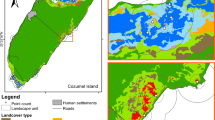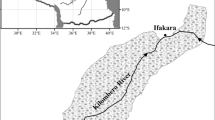Abstract
While wetlands have been converted into farmlands, large amounts of farmlands are now being abandoned, and this novel habitat is expected to be inhabited by species which depend on wetlands. Here we examined the effects of habitat and landscape variables on the densities of wetland bird species in abandoned farmlands. We surveyed birds in abandoned farmlands with different patch area, habitat, and landscape variables in Kushiro district, eastern Hokkaido, northern Japan. We also surveyed birds in 15 ha of the remaining wetlands as a reference habitat. We used abundance-based hierarchical community models (HCMs) to estimate patch-level estimates of abundance of each species based on sampling plots data that only partially covered the studied patches. We observed 14 wetland species and analyzed them with HCMs. Abandoned farmland patch areas had significant positive effects on the densities of two species. Tree densities and shrub coverage exerted positive and negative effects on some species. Amounts of surrounding wetland/grassland had positive effects on many species. Ensemble of species-level models suggested that 24.7 and 10.6 ha of abandoned farmlands would be needed to harbor a comparable total abundance and species richness in 15-ha wetlands, respectively. These required amounts can be increased/decreased depending on the covariates. The use of HCMs allows us to predict species- and community-level responses under varied conditions based on incomplete sampling data. A quantity of 1.6 times larger areas of abandoned farmlands may be required to restore wetland bird communities in eastern Hokkaido.





Similar content being viewed by others
References
Askins RA (2001) Sustaining biological diversity in early successional communities: the challenge of managing unpopular habitats. Wildl Soc Bull 29:407–412
Bibby CJ, Burgess ND, Hill DA, Mustoe SH (2000) Bird census techniques, 2nd edn. Academic Press, San Diego
Cam E, Nichols JD, Hines JE, Sauer JR, Alpizar-Jara R, Flather CH (2002) Disentangling sampling and ecological explanations underlying species–area relationships. Ecology 83:1118–1130
Connor EF, McCoy ED (1979) The statistics and biology of the species–area relationships. Am Nat 113:791–833
Connor EF, Hosfield E, Meeter DA, Niu X (1997) Tests for aggregation and size-based sample-unit selection when sample units vary in size. Ecology 78:1238–1249
Connor EF, Courtney AC, Yoder JM (2000) Individuals-area relationships: the relationship between animal population density and area. Ecology 81:734–748
Cramer VA, Hobbs RJ, Standish RJ (2008) What’s new about old fields? Land abandonment and ecosystem assembly. Trends Ecol Evol 23:104–112
Crouzeilles R, Curran M (2016) Which landscape size best predicts the influence of forest cover on restoration success? A global meta-analysis on the scale of effect. J Appl Ecol 53:440–448
Davidson NC (2014) How much wetland has the world lost? Long-term and recent trends in global wetland area. Marine Freshw Res 65:934–941
Davis SK (2004) Area sensitivity in grassland passerines: effects of patch size, patch shape, and vegetation structure on bird abundance and occurrence in southern Saskatchewan. Auk 121:1130–1145
Desrochers A, Hannon SJ (1997) Gap crossing decisions by forest songbirds during the post-fledging period. Conserv Biol 11:1204–1210
Dunning JB, Danielson BJ, Pulliam HR (1992) Ecological processes that affect populations in complex landscapes. Oikos 65:169–175
Ellis EC, Goldewijk KK, Siebert S, Lightman D, Ramankutty N (2010) Anthropogenic transformation of the biomes, 1700 to 2000. Global Ecol Biogeogr 19:589–606
Fairbairn SE, Dinsmore JJ (2001) Local and landscape-level influences on wetland bird communities of the prairie pothole region of Iowa, USA. Wetlands 21:41–47
Finlayson CM, Spiers AG (1999) Global review of wetland resources and priorities for wetland inventory. Wetlands International 53, Supervising Scientist, Canberra
Grant TA, Madden E, Berkey GB (2004) Tree and shrub invasion in northern mixed-grass prairie: implications for breeding grassland birds. Wildl Soc Bull 32:807–818
GSI (2000) National survey of lakes and wetlands. Geospatial Information Authority of Japan (GSI), http://www.gsi.go.jp/kankyochiri/gsilake.html (in Japanese)
Higuchi H, Morioka H, Yamagishi S (1997) The encyclopedia of animals in Japan., vol 4. In: Birds II. Heibonsha (in Japanese)
Huth N, Possingham HP (2011) Basic ecological theory can inform habitat restoration for woodland birds. J Appl Ecol 48:293–300
James FC, Wamer NO (1982) Relationships between temperate forest bird communities and vegetation structure. Ecology 63:159–171
Kéry M, Royle JA (2016) Applied hierarchical modeling in ecology: analysis of distribution, abundance and species richness using R and BUGS, vol 1. In: Prelude and static models. Academic Press, San Diego
Litvaitis JA (1993) Response of early successional vertebrates to historic changes in land use. Conserv Biol 7:866–873
MAFF (2011) On the current status of abandoned cropland. Ministry of Agriculture, Forestry and Fisheries (MAFF), Tokyo. http://www.maff.go.jp/j/nousin/tikei/houkiti/pdf/genjou1103.pdf (in Japanese)
Matthysen E, Adriaensen F, Dhondt AA (1995) Dispersal distances of nuthatches, Sitta europaea, in a highly fragmented forest habitat. Oikos 72:375–381
Mazerolle MJ, Villard M-A (1999) Patch characteristics and landscape context as predictors of species presence and abundance: a review. Ecoscience 6:117–124
ME (2005) Ecosystems and human well-being: synthesis. Millennium Ecosystem Assessment (ME), Island Press, Washington DC
Nakamura T, Yamaguchi S, Iijima K, Kagawa T (1968) A comparative study on the habitat preference and home range of four species of the Genus Emberiza on peat grassland. J Yamashina Inst Ornith 5:313–336 (in Japanese)
Plummer M (2013) JAGS: just another gibbs sampler. http://mcmc-jags.sourceforge.net/
Queiroz C, Beilin R, Folke C, Lindborg R (2014) Farmland abandonment: threat or opportunity for biodiversity conservation? A global review. Front Ecol Environ 12:288–296
R Core Team (2015) R: a language and environment for statistical computing. R Foundation for Statistical Computing Vienna, Austria
Ralph CJ, Geupel GR, Pyle P, Martin TE, DeSante DF (1993) Handbook of field methods for monitoring landbirds, vol 0. USDA For. Serv. Gen. Tech. Rep. PSW-GTR-144
Ramankutty N, Foley JA (1999) Estimating historical changes in global land cover: croplands from 1700 to 1992. Global Biogeochem Cycle 13:997–1027
Rotenberry JT, Wiens JA (1980) Habitat structure, patchiness, and avian communities in North American steppe vegetation: a multivariate analysis. Ecology 61:1228–1250
Ruffell J, Didham RK (2016) Towards a better mechanistic understanding of edge effects. Landsc Ecol 31:2205–2213
Sirami C, Seymour C, Midgley G, Barnard P (2009) The impact of shrub encroachment on savanna bird diversity from local to regional scale. Divers Distrib 15:948–957
Su Y-S, Yajima M (2013) R2jags: a package for running jags from R. http://CRAN.R-project.org/package=R2jags
Takagawa S et al (2011) JAVIAN database: a species-level database of life history, ecology and morphology of bird species in Japan. Bird Res 7:R9–R12 (in Japanese)
Taki H, Murao R, Mitai K, Yamaura Y (2017) The species richness/abundance–area relationships of bees in early successional tree plantation. Basic Appl Ecol. https://doi.org/10.1016/j.baae.2017.09.002
Thompson SJ, Arnold TW, Fieberg J, Granfors DA, Vacek S, Palaia N (2016) Grassland birds demonstrate delayed response to large-scale tree removal in central North America. J Appl Ecol 53:284–294
Toyoshima Y, Yamaura Y, Mitsuda Y, Yabuhara Y, Nakamura F (2013) Reconciling wood production with bird conservation: a regional analysis using bird distribution models and forestry scenarios in Tokachi district, northern Japan. For Ecol Manage 307:54–62
Triantis KA, Guilhaumon F, Whittaker RJ (2012) The island species–area relationship: biology and statistics. J Biogeogr 39:215–231
Urban D, Keitt T (2001) Landscape connectivity: a graph-theoretic perspective. Ecology 82:1205–1218
Wiens JA, Rotenberry JT (1981) Habitat associations and community structure of birds in shrubsteppe environments. Ecol Monogr 51:21–41
Williams MR, Lamont BB, Henstridge JD (2009) Species–area functions revisited. J Biogeogr 36:1994–2004
Yamaura Y, Katoh K, Takahashi T (2008a) Effects of stand, landscape, and spatial variables on bird communities in larch plantations and deciduous forests in central Japan. Can J For Res 38:1223–1243
Yamaura Y, Kawahara T, Iida S, Ozaki K (2008b) Relative importance of the area and shape of patches to the diversity of multiple taxa. Conserv Biol 22:1513–1522
Yamaura Y, Connor EF, Royle JA, Itoh K, Sato K, Taki H, Mishima Y (2016a) Estimating species–area relationships by modeling abundance and frequency subject to incomplete sampling. Ecol Evol 6:4836–4848
Yamaura Y, Kéry M, Royle JA (2016b) Study of biological communities subject to imperfect detection: bias and precision of community N-mixture abundance models in small-sample situations. Ecol Res 31:289–305
Acknowledgements
We thank J. Morimoto and K. Yabe for useful comments for this study. We also thank the members of the Nature Protection Office of Kushiro District, owners of the study site and the members of the Laboratory of Forest Ecosystem Management of Hokkaido University for their assistance in our field survey. This study was supported by the Environmental Research and Technology Development Fund (4-1504) of the Ministry of the Environment of Japan. Y. Yamaura was supported by JSPS KAKENHI Grant Numbers JP26292074 and JP16KK0176.
Author information
Authors and Affiliations
Corresponding author
Additional information
Communicated by Kirschel.
Appendices
Appendix A: Schematic illustration of territory mapping method
Sampling plot

We here illustrate the territory mapping procedure for a certain species. The rectangle depicted by a real line shows a sampling plot. We recorded the locations of individuals detected at each survey visit (showed by the black dots) and drew their hypothetical circle territories. The radius of the circles was based on the available information of the territory size of the species. Gray, white, and diagonal circles show the individual territories recorded at the different visits.
We then treated circle territories in the following two cases as separate territories: (a) territories recorded at the same visits and (b) territories detected at the different visits but did not overlap with each other. We treated circle territories in the following two cases as a single territory: (c) territories detected at the different visits overlapped with each other and (d) more than half of the territories were included in the plot. Finally, when less than half of the territories was included in the plots, territories were treated as 0.5 territories (e). In this example, the total number of territories (summed number) is 7.5.
Appendix B
See Table 1.
Appendix C
See Table 2.
Appendix D
See Table 3.
Appendix E
See Table 4.
Rights and permissions
About this article
Cite this article
Hanioka, M., Yamaura, Y., Yamanaka, S. et al. How much abandoned farmland is required to harbor comparable species richness and abundance of bird communities in wetland? Hierarchical community model suggests the importance of habitat structure and landscape context. Biodivers Conserv 27, 1831–1848 (2018). https://doi.org/10.1007/s10531-018-1510-5
Received:
Revised:
Accepted:
Published:
Issue Date:
DOI: https://doi.org/10.1007/s10531-018-1510-5




